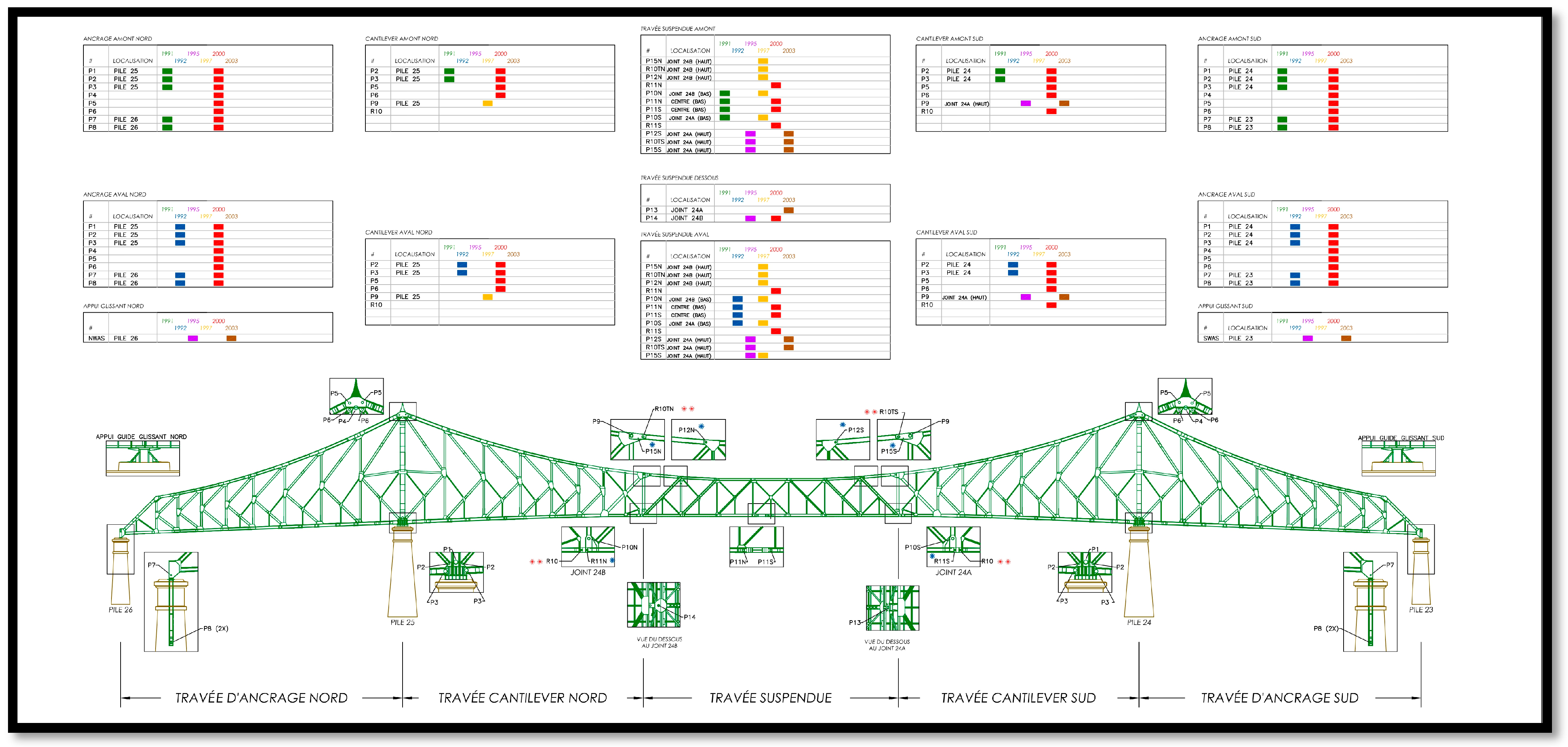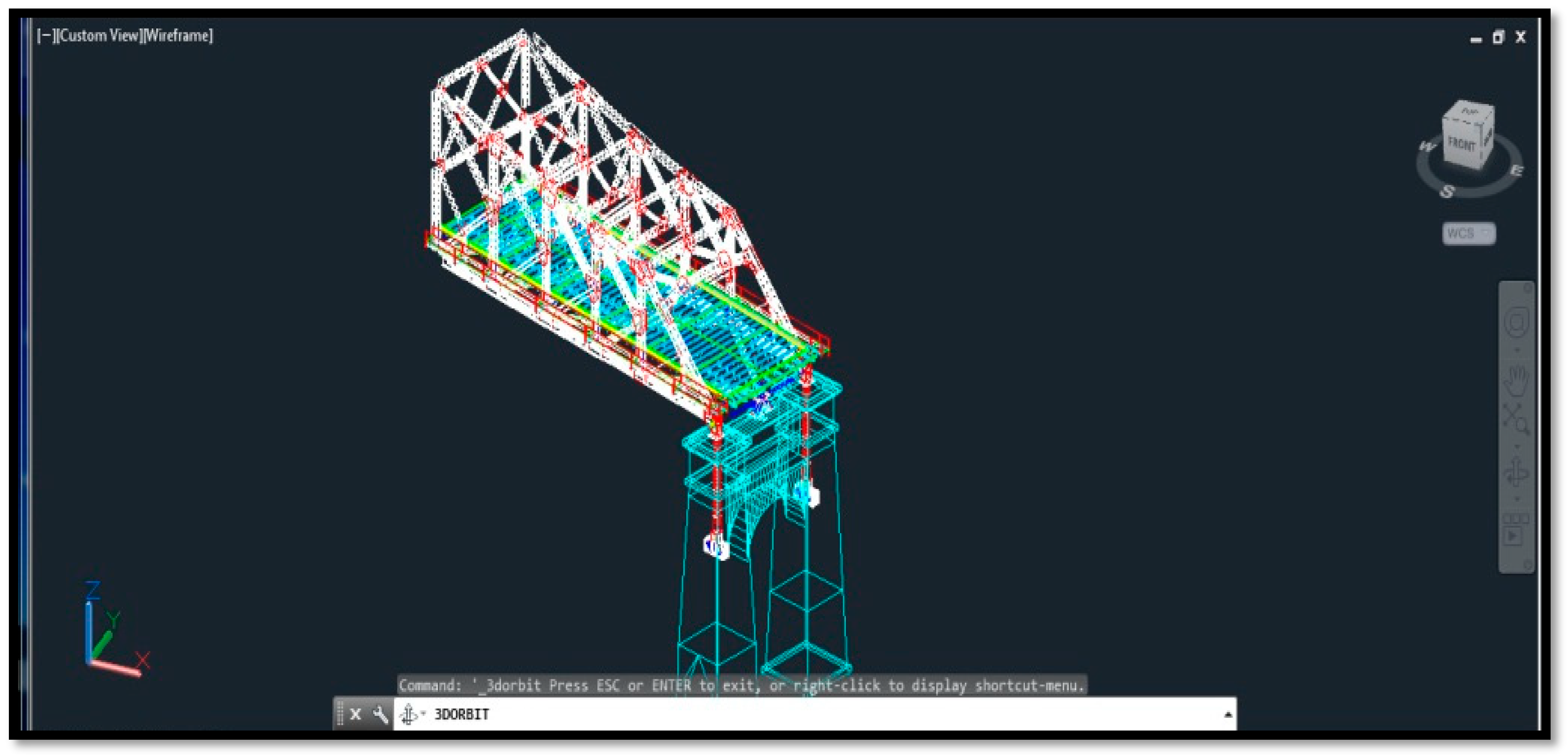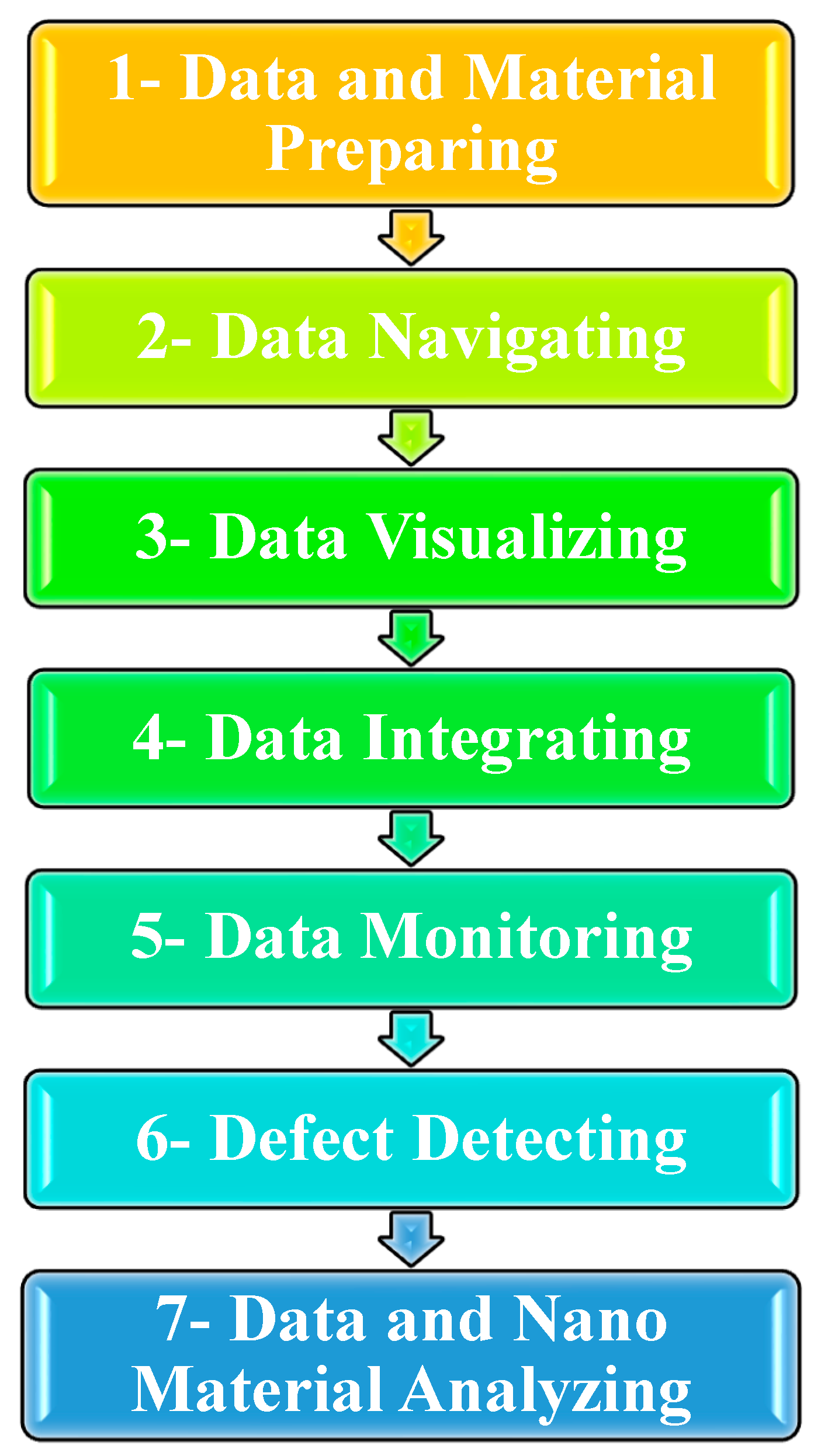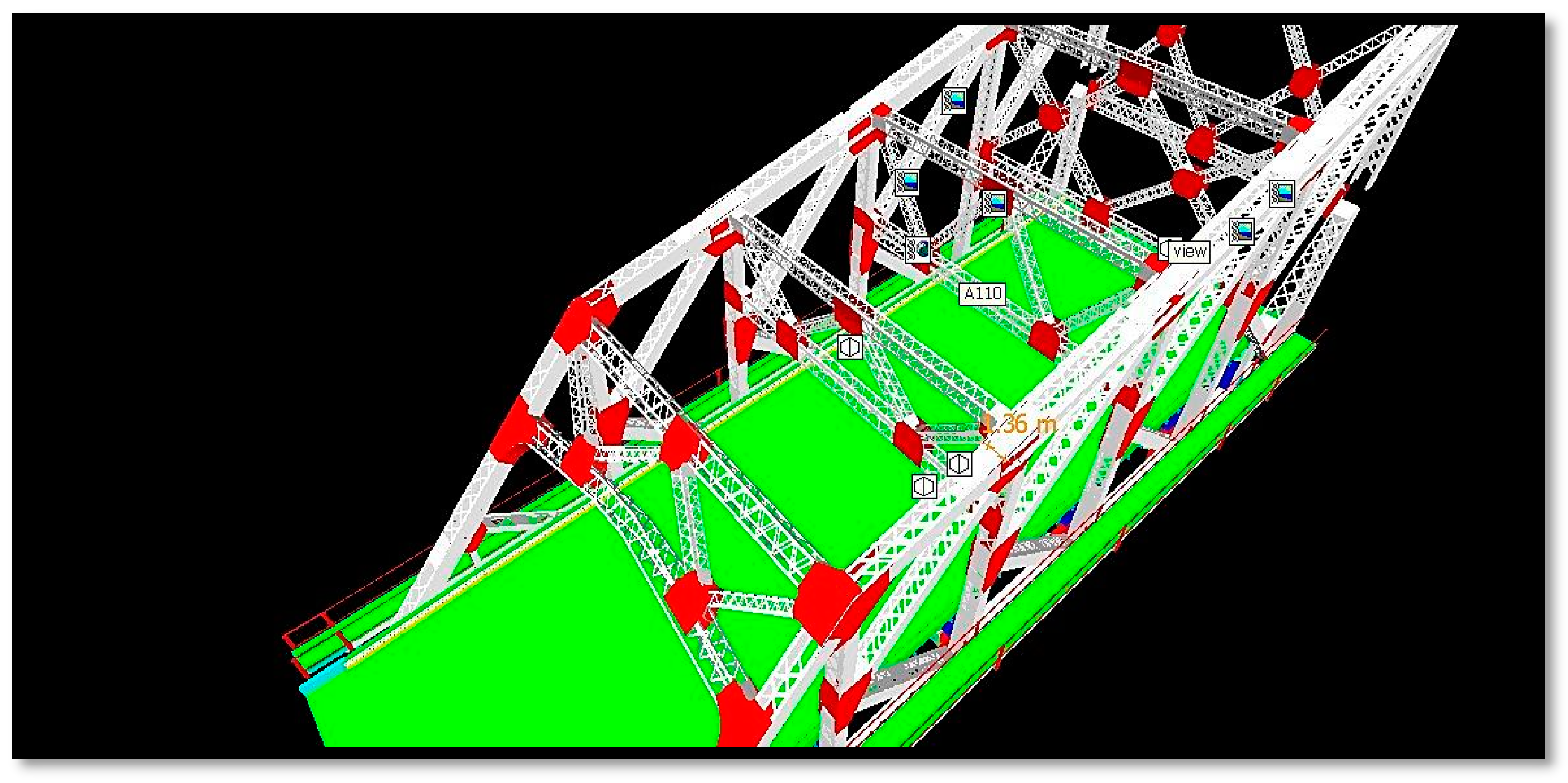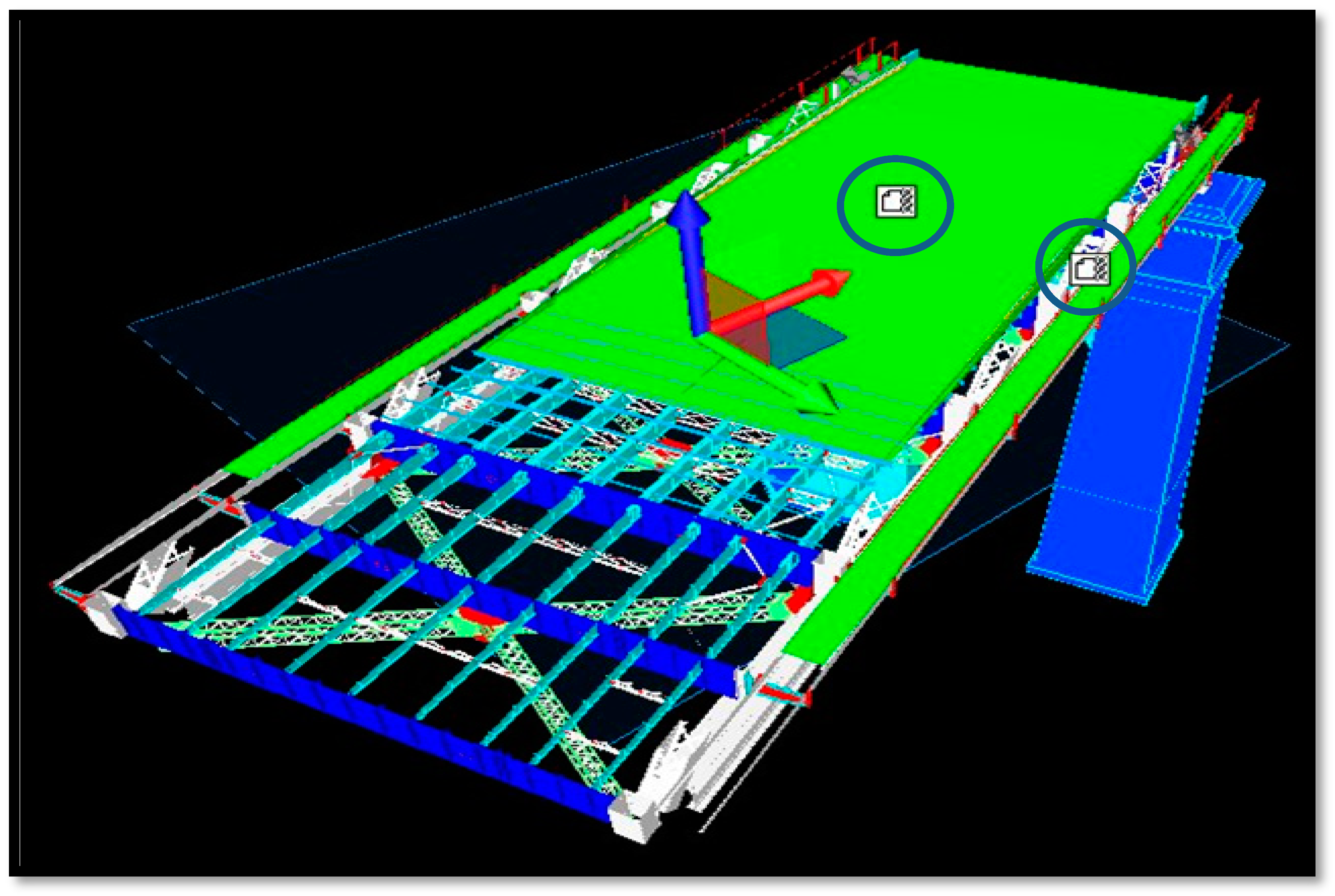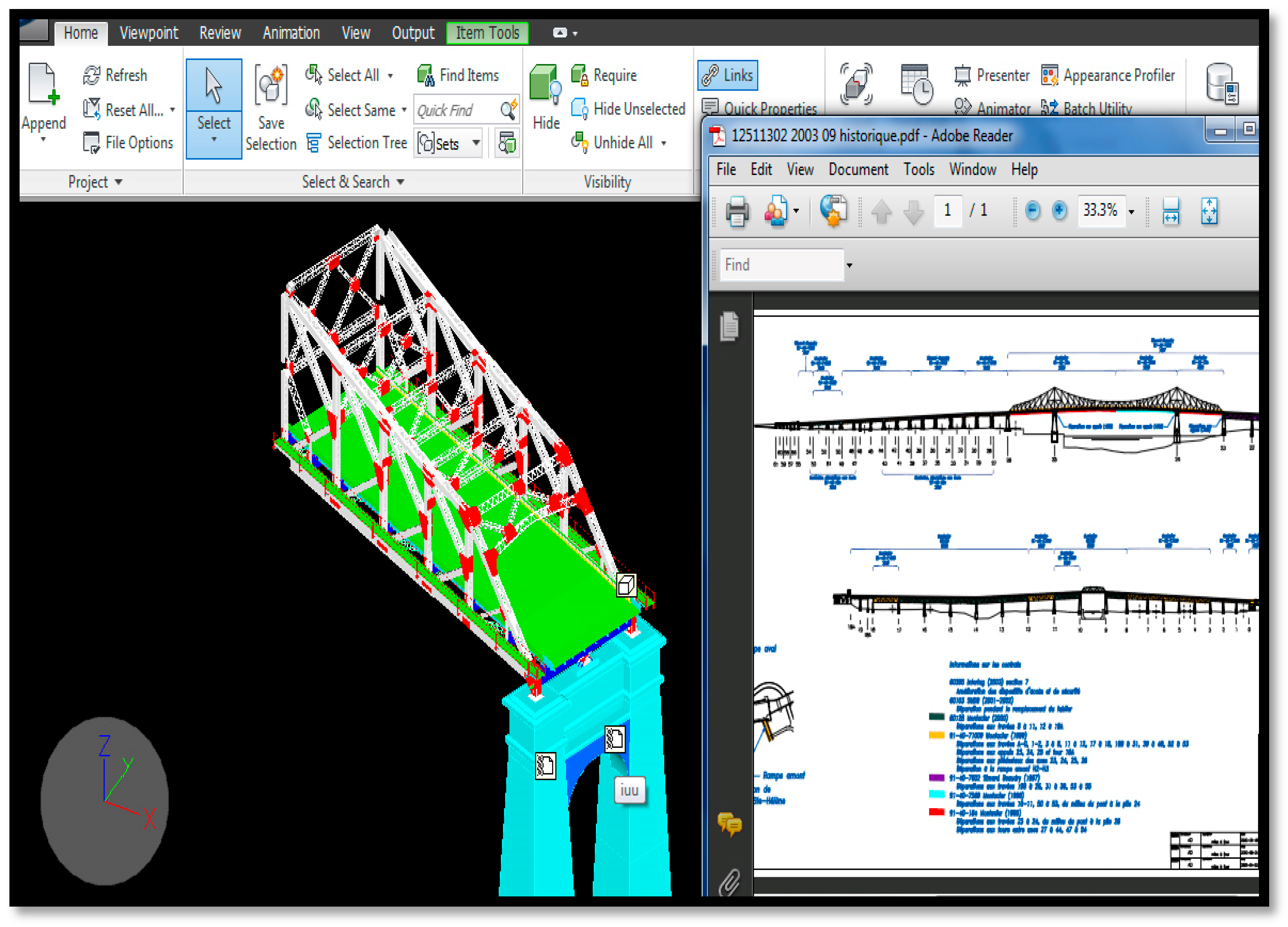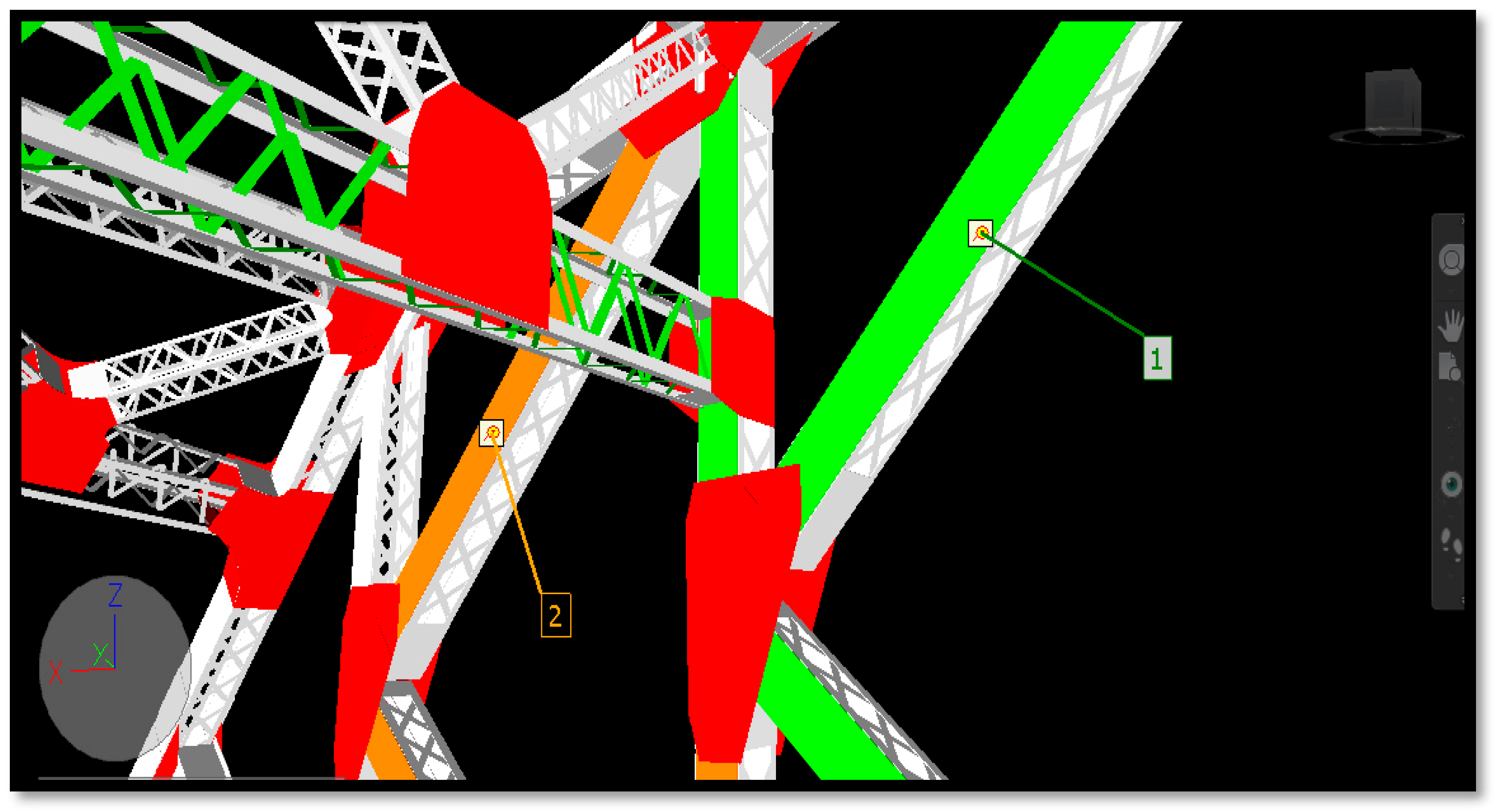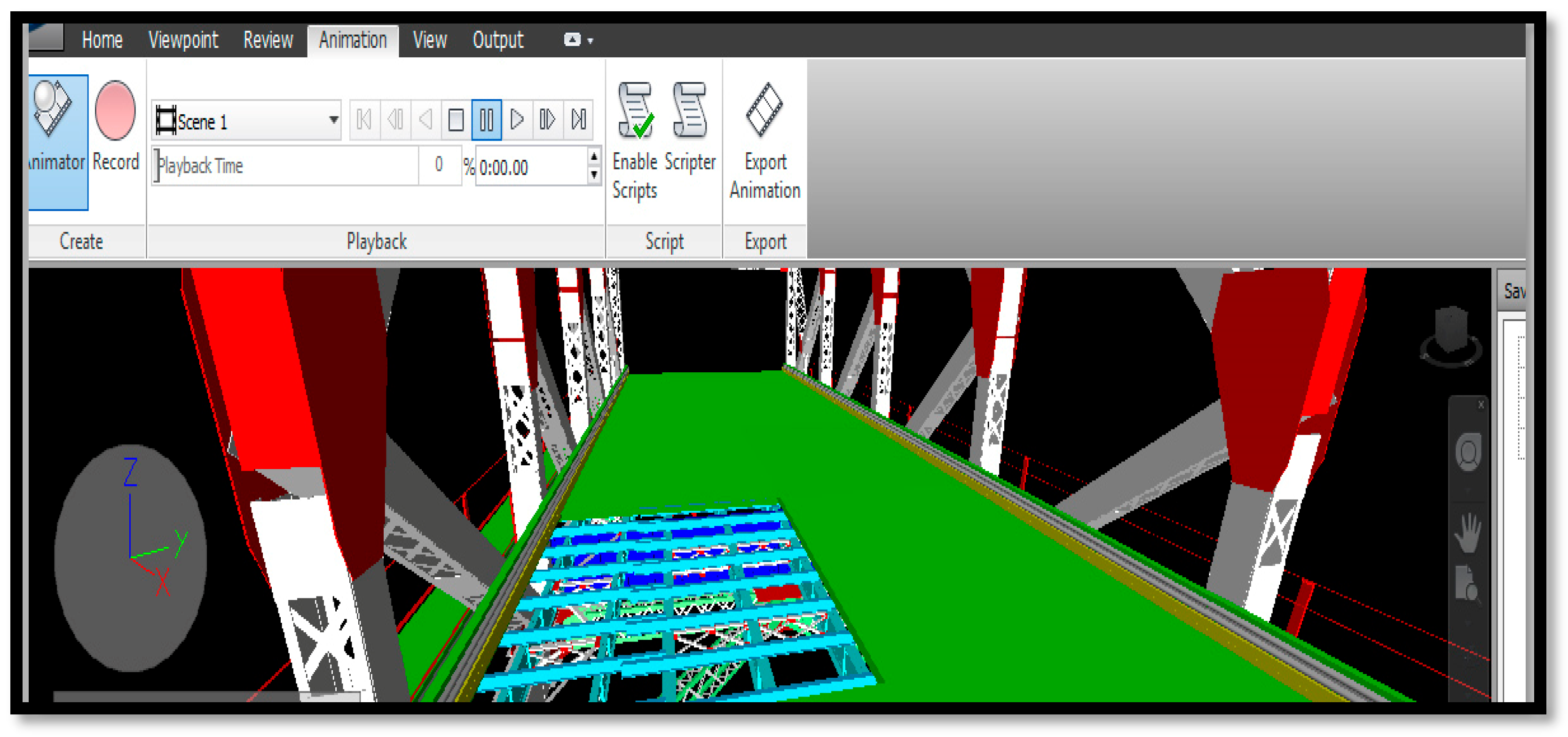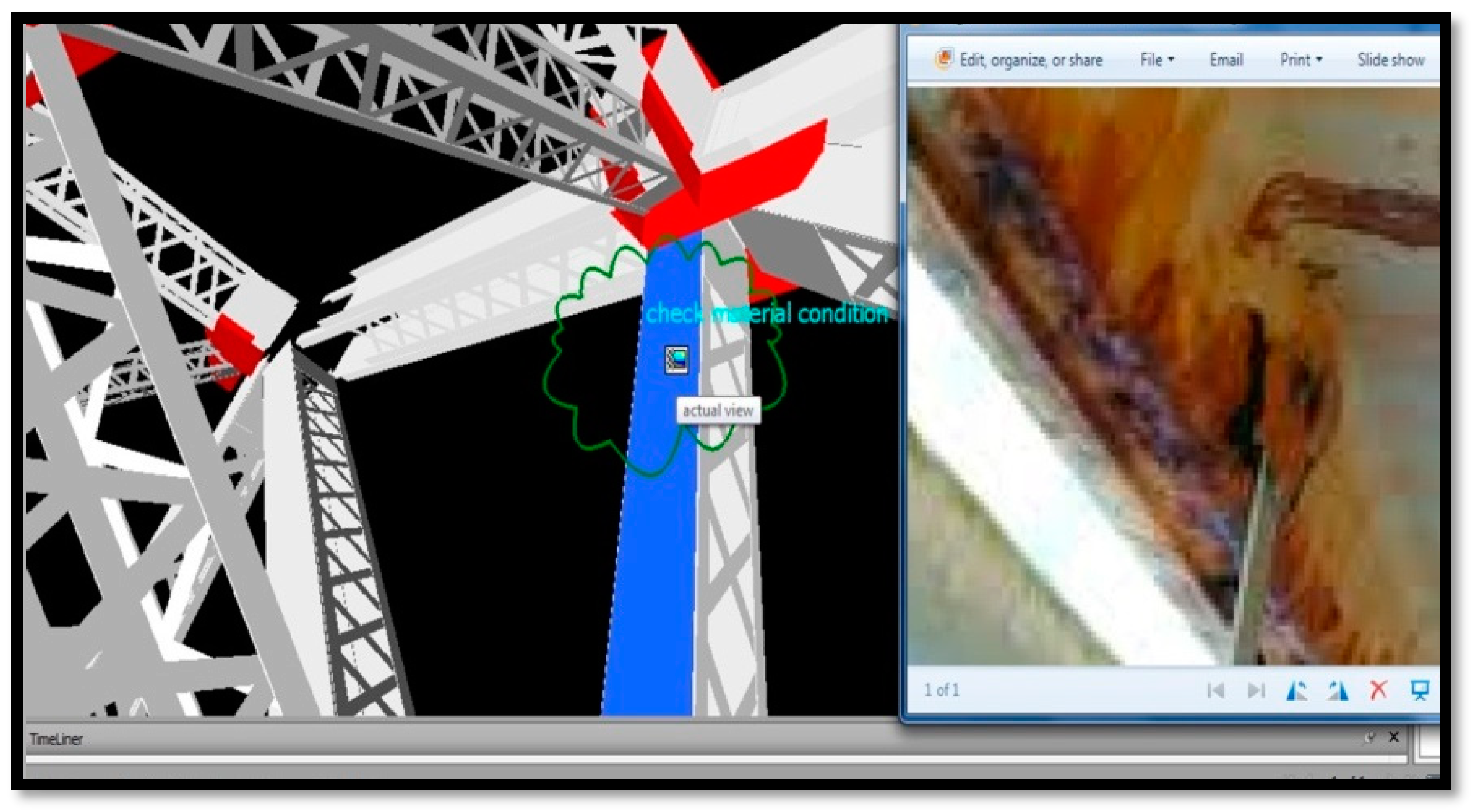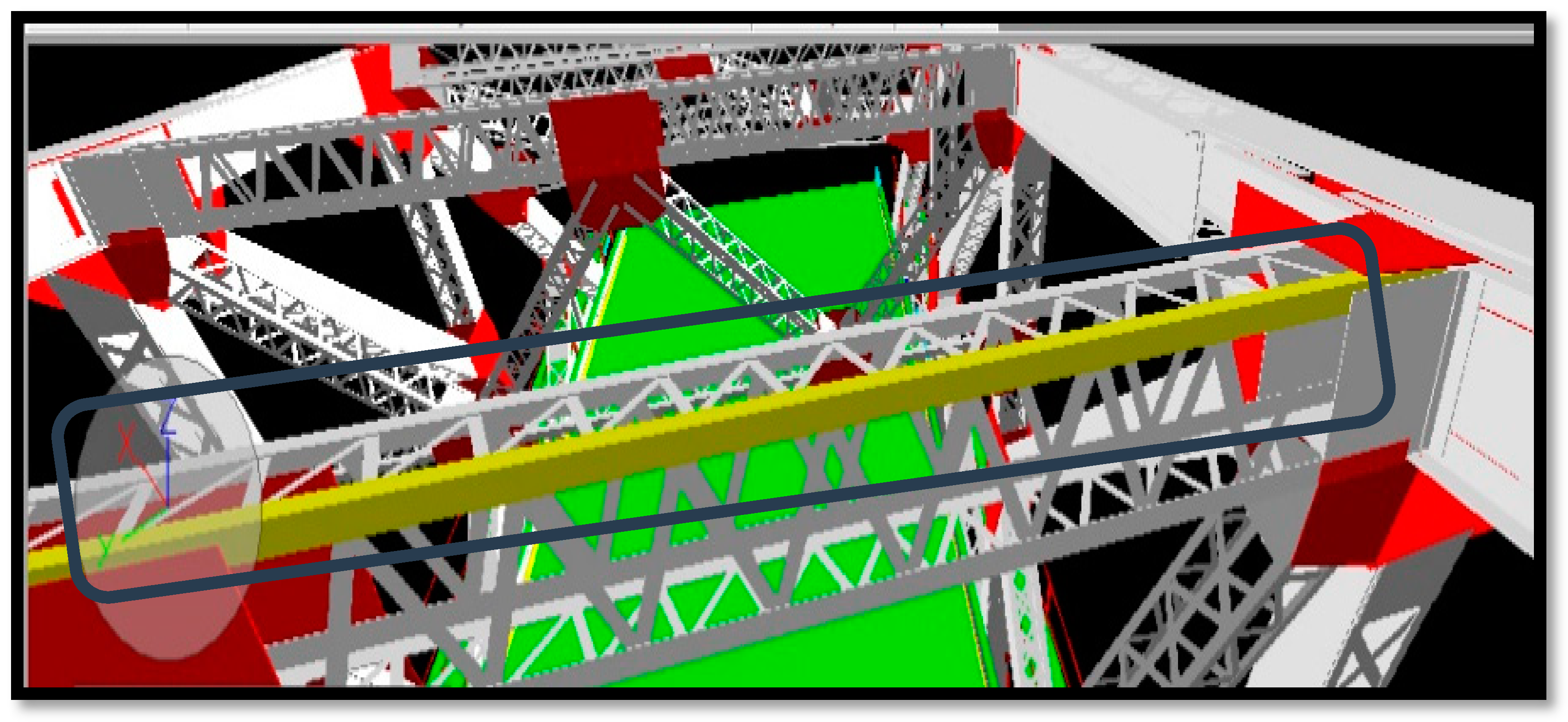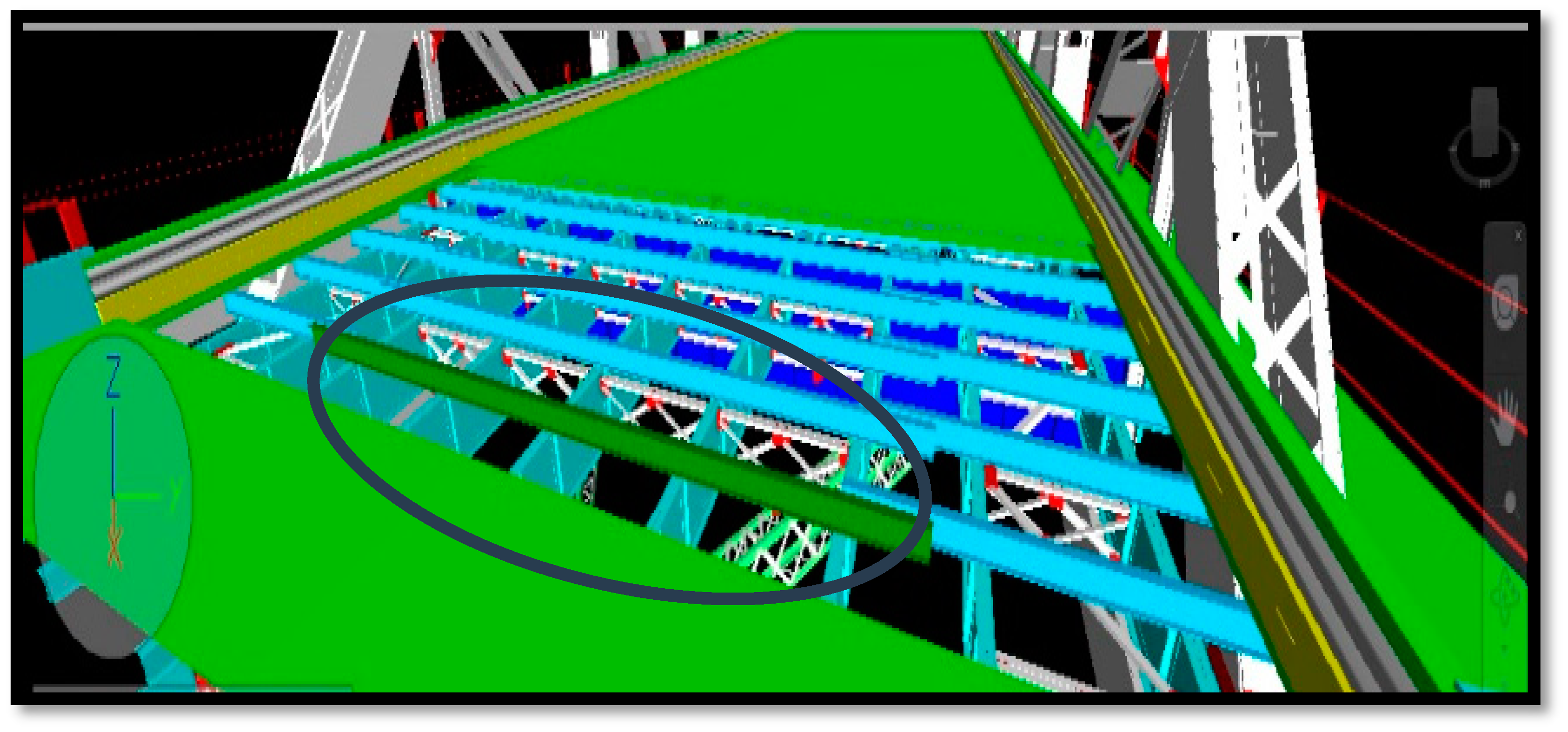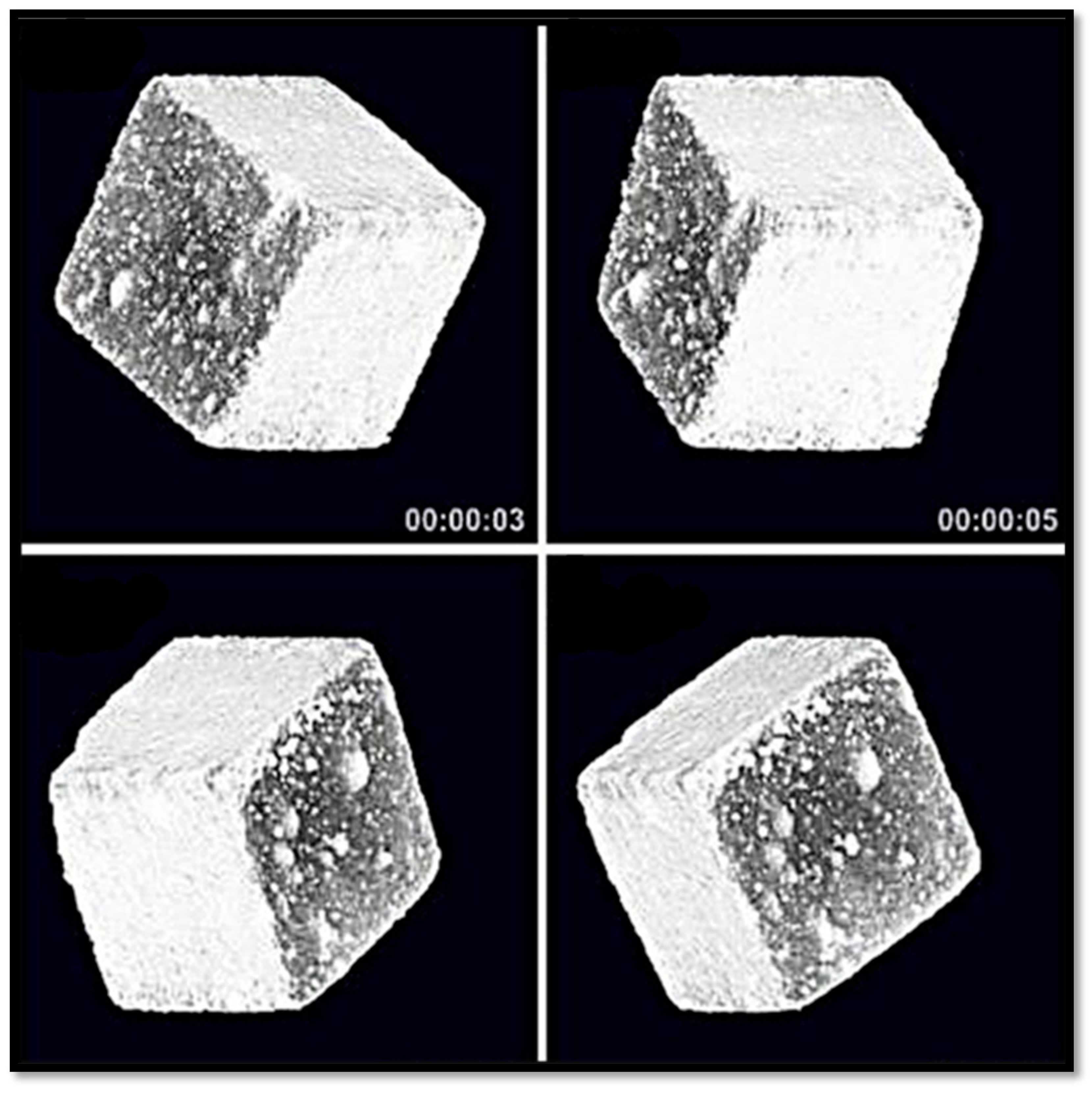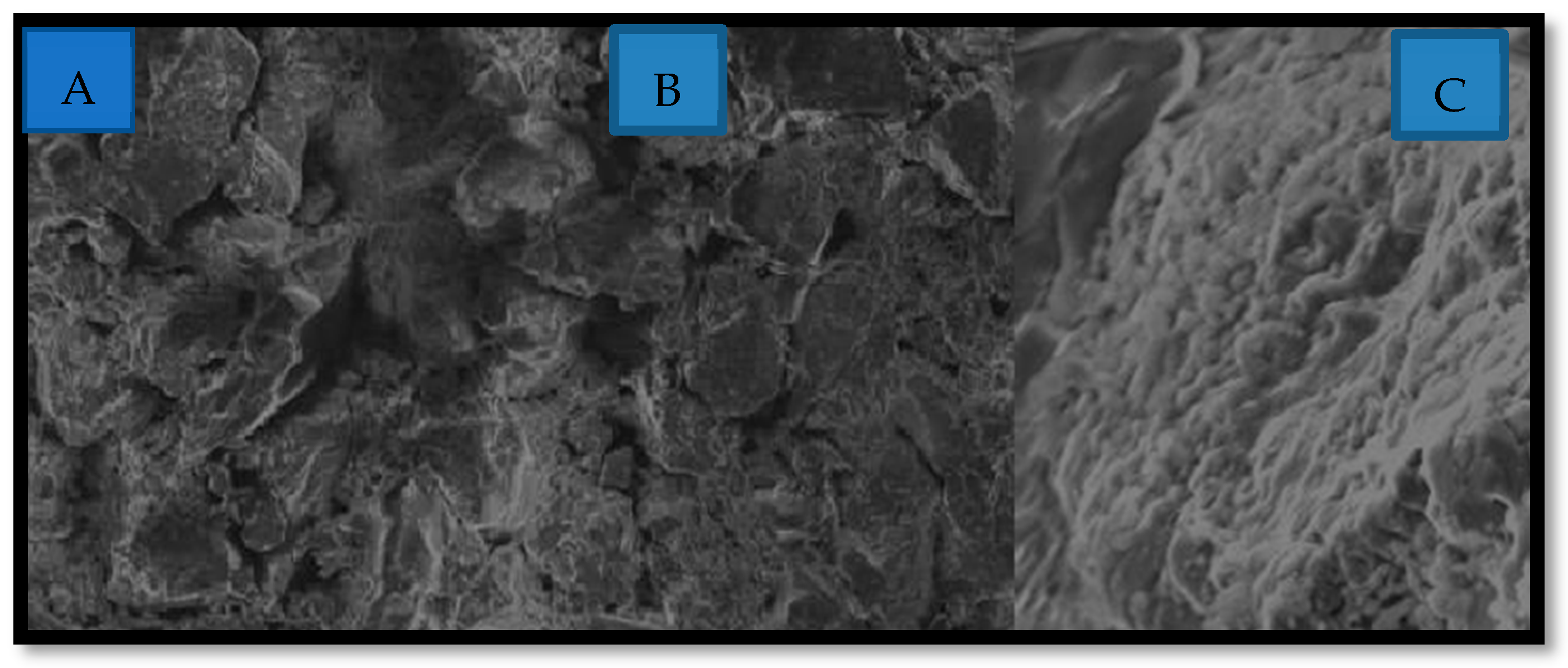1. Introduction
Bridge piers are fundamental to the structural integrity of bridges, serving as load-bearing components that support spans and transfer loads to the foundation. Unlike other bridge elements, piers are subjected to unique environmental and operational challenges, including continuous exposure to water, sediment abrasion, and chemical degradation from salts and pollutants. These factors accelerate material deterioration, leading to defects such as cracking, spalling, and loss of structural integrity.
The assessment and maintenance of bridge piers are crucial for guaranteeing the long-term safety and stability of bridge structures. Traditional methods, such as manual inspections and periodic underwater surveys, are time-consuming, labor-intensive, and prone to human error. The study [
1] proposes an innovative 4D digital model that integrates Bridge Information Modeling (BrIM) with advanced defect detection technologies to enhance the monitoring and treatment of pier-specific defects.
This research focuses on the use of nanomaterial-based consolidation methods, coupled with non-destructive techniques, like CT scanning and SEM analysis, to restore sandstone piers affected by environmental stresses. By incorporating time-based simulations and predictive tools, the 4D model offers a comprehensive framework for tracking changes in pier conditions and planning proactive maintenance.
While the methodologies discussed may benefit other bridge components, this study emphasizes bridge piers due to their critical role and susceptibility to unique challenges. The findings aim to advance defect detection and restoration practices, contributing to the long-term preservation of these vital structural elements.
The assessment of building conditions and related risks is a critical task for maintaining structural integrity and safety. Traditionally, identifying defects in buildings has relied heavily on manual inspection methods, which can be time-consuming, labor-intensive, and prone to human error [
2,
3,
4]. The presence of construction defects, often resulting from human error or oversight, can significantly affect the building’s performance, durability, and overall safety [
5,
6,
7]. To address this issue, the development of automated techniques for defect detection has gained significant attention [
8,
9,
10,
11].
Finding defects has always been crucial to assessing a building’s condition and risk. The sensors may be positioned anywhere and targeted at any part of the structure, and the photos they take can be quantitatively interpreted utilizing defect photography employing 3D range sensors from an external exposure position. Study [
12] presented an enhancement of a recently developed technique for recovering 3D BIM objects from 3D range surveying data in order to detect object defects. A technique for modeling and 3D-altering building defects utilizing several types of data and sensors was developed in this study. The benefit of the method was the adaptability it offered in addressing complex defects for which a single method is inadequate.
At the moment, dimensional observing and defect modeling systems are restricted to building elements with regular shapes and uniform thickness. Additional research is needed to expand to other types of building elements and defects with more complex geometries (e.g., trusses, columns, piers, and supports) [
12,
13]. It is suggested to utilize advanced technologies, such as noncontact sensing systems, artificial intelligence, and machine learning, to accurately and efficiently identify defects, leading to next-generation measurement technology for structural health monitoring [
14,
15].
Recent advances have led to the investigation of non-contact approaches for dynamic behavior analysis. One such approach is 3D Laser Doppler Vibrometry (3D LVD), which measures surface vibrations with great precision and without causing any damage. This method employs laser interferometry to assess the velocity of surface points on a structure, facilitating the characterization of dynamic behavior under different loading conditions [
16].
The contactless nature of 3D LVD makes it ideal for complicated geometries or circumstances where standard approaches may be impracticable. Further research into this approach and its applications in building flaw identification, coupled with other sophisticated technologies, such as Digital Image Correlation and UAV-based inspections, offers promise for a more complete knowledge of structural health and performance [
17,
18,
19]. A combination of unmanned aerial vehicle (UAV) or unmanned aircraft system (UAS) flights and terrestrial laser scanner flights were carried out in [
20] in order to thoroughly inspect such a complicated building. Large volumes of data were produced by the studies, offering a comprehensive and worldwide metric record of Italy’s Frinco Castle. However, it was essential to combine this data into coherent and consistent 2D and 3D outputs in order to speed up the restoration process. Therefore, this study’s main goals were to fuse point clouds from several sensors, align different datasets, refine metric data, and evaluate the correctness of these procedures.
Furthermore, the sandstone at bridge piers has been adversely affected by the combined impact of groundwater exposure and changing temperatures, both of which are characteristic environmental factors in the region. These factors have led to the disintegration of stone, detachment of layers, and mechanical damage caused by factors such as salt crystallization, fluctuations in relative humidity, and temperature variations. Moreover, air pollution and evaporation have led to chemical deterioration, causing colored crusts to form on stone surfaces and causing the presence of flaking forms. In addition to the effect of macro-scale agents, such as earthquakes, sandstone’s durability has been compromised by micro-scale weathering processes, including the effects of wind, rain, and temperature fluctuations. These processes have rapidly altered the stone’s petro-physical properties, leading to the formation of cracks, fissures, and exfoliation. As a result, these vital structures have suffered significant damage, affecting their structural integrity and aesthetic value.
Combining BIM data with 4D range images opens up a wide range of options. The necessity of precise and trustworthy information in the construction industry is emphasized by the significance of recording building modifications throughout their entire cycle. One useful technique for keeping pertinent data is Building Information Modeling (BIM). Data registration using the Iterative Closest Point (ICP) algorithm and the accuracy of 3D point cloud models was assessed in [
21]. The article emphasized the importance of assessing the quality of 3D modeling.
The research team [
22] introduced the use of machine learning in combination with 3D scanning techniques to identify defects in a variety of construction components, including walls, pillars, staircases, ceilings, and foundations. They took actual pictures of the exterior and interior building components using LiDAR and ZED camera systems. Because of its affordable solution, which offered a cheap initial speculation and reduced lifecycle costs, it was possible for both large construction businesses and smaller contractors.
In order to avoid disastrous failures, it is crucial to quickly detect and evaluate any possible structural damage to building structures. The requirement for a trustworthy technique to identify structural damage is emphasized by [
23]. Early discovery can guarantee the long-term preservation and safety of structures and assist with stopping more damage. The recommendation was to focus on artificial intelligence. Advanced AI algorithms allow us to automate the process of analyzing point data and creating 4D Defects Information Models 4D DIM. This significantly speeds up the digitization process, which is important when examining larger and more complex buildings.
One of the most important areas for visualizing exact information is bridge structural modeling. It was recommended in [
24] that global design reference and as-built data be registered. In that study, a unique Artificial Neural Network (ANN)-based registration method was presented. Due to the small amount of error between the as-built and design models, the results showed that the proposed registration method is achievable. As a result, the proposed technique may be used as a registration method for laser scanning bridge projects. Deep Learning (DL) was proposed as a way to enhance the registration process.
Study [
25] represented an automated progression to form filtering data of the as-built truss model with its CAD model to identify and correct geometric defects and imprecision. Instead of processing the 3D model points by hand, the BPNN architecture offered the finest coordinates processing training. It was applied to improve the process of establishing points between the input scanned coordinates of the as-built model and the output of the genuine CAD coordinates. By lowering the mean square error between the network output and the intended output, this was achieved. The RMSE in x, y, xy, z, and space vector R for all processing jobs was computed in a way that was deemed acceptable.
Damages occur during the construction or transportation of the structure. However, because assessment systems are dependent on measurements at specific sites and times and are not part of full electronic approaches, they are unable to adequately detect problems that occur during the construction process. In order to avoid significant rework costs, it is crucial to constantly monitor building advancements. Through a case study of a bridge in Canada, [
26] demonstrated an automated advancement to register remote sensing data of the as-built model with BrIM (Bridge Information Model) for a constructed bridge in order to validate the intended method for monitoring the structural defects.
Bridges are dynamic structures constantly exposed to time-dependent forces, such as wind, traffic, and seismic events, which necessitate advanced methods for understanding and mitigating their responses. Despite the significant advancements in digital modeling techniques, such as 4D BrIM (Bridge Information Modeling) systems, these models often lack the capability of performing structural dynamic analyses [
27], limiting their application in assessing and predicting dynamic responses under various load conditions. To address this limitation, integrating structural dynamic analysis into digital models is crucial for evaluating behaviors such as oscillations, vibrations, and stress distribution caused by non-stationary and time-varying loads. Recent research offers promising methodologies to enhance this capability. For example, the study [
28] by the
Journal of Sound and Vibration presents a 2D interpolation-enhanced approach for the efficient buffeting analysis of long-span bridges under non-stationary winds, providing a framework to simulate fluctuating wind forces and their impact on structural elements. Similarly, research published in Mechanical Systems and Signal Processing demonstrates the utility of Kalman-type filtering algorithms to estimate the full-field dynamic response of floating bridges in real time, using sensor-based data to refine predictions and monitor responses dynamically.
Furthermore, the
ASCE Journal of Structural Engineering [
29] highlights the importance of analyzing time-varying wind spectra and coherences for typhoon-induced buffeting in long-span bridges, emphasizing the need for time-dependent modeling techniques to capture complex interactions between environmental loads and structural behavior. By incorporating these methodologies, digital models can be transformed into comprehensive tools for evaluating and mitigating the effects of dynamic forces, enhancing their utility in real-world applications. This integration would allow for predictive maintenance, improved safety, and the design of resilient infrastructure capable of withstanding the challenges posed by dynamic environmental and operational conditions.
In previous studies, researchers periodically scanned construction sites with a multi-source of data and sensors, produced models of each case study, and identified geometric irregularities as errors. A digital and automated inspection process is required to address variations and construction errors. Developing the usage of 4D CAD models to identify defects and errors in building components is another way to address this investigation.
This research offers an innovative approach to develop an integrated 4D digital model that combines Bridge Information Modeling (BrIM) with several types of data to enhance the detection of defects, particularly in complex geometries. It also examines the application of digital monitoring for comprehensive and structural continuous assessment, focusing on effective defect modeling in irregular and intricate construction elements, such as trusses.
Additionally, this study intends to explore the role of 4D digital defect detection and monitoring to integrate several types of data and designed models, ultimately improving the effectiveness of defect modeling, supporting the automation of defect identification and accelerating digitization, with a focus on long-term structure safety and maintenance. The integration of time dimension into the 4D model provides dynamic tools for exploring changes over time, allowing for analysis and maintenance planning.
Moreover, this study aims to introduce a sustainable method for consolidating buildings (bridge piers) using a nanocomposite combination. The CT scanning technique, XRF and SEM-EDX analysis have been applied for evaluating the efficacy of the nanocomposite’s consolidant and chemical composition. As a non-destructive technique, a CT scan offers precise details of the surface morphology and the interior structure [
30,
31,
32,
33,
34,
35], while SEM-EDX analysis [
36,
37,
38,
39,
40] exposes the alteration in the surface morphology and stone characteristics. The properties of the sandstone were compared before and after applying the stone strengthener and nanomixture consolidants. By exploring the combined use of these technologies, this research endeavors to contribute to this emerging field by investigating the synergistic potential of these technologies in the development of a novel and sustainable approach to bridge infrastructure maintenance.
3. Methodology
As mentioned above, all previous data were integrated together with the time into a 4D model of the bridge. In order to achieve this, adopting a clear method plan as indicated in
Figure 3, was very necessary due to the complicated relationship between manual, schedule, and digital data. At this point, incorporating all available data, such as maintenance reports, related time events, and detailed drawings, into the 4D CAD model was the major priority of this work. The application of this practice will certainly help in ensuring compatibility among all inspectors who are interesting in direct accessing of the project’s data.
Figure 3 clarifies the methodological steps followed in the study. Additional information, discussions, and results regarding the approach are provided in the ensuing sections.
3.1. Data and Material Preparing
The suggested method in this case study is related to the visualization concept. The management model system can be explored by interacting with the 4D model. Appropriate data are directly attached to the components of the 4D model. Inspectors can realize the model, check maintenance data, and issue effective decisions and attach them to the 4D model component.
The sandstone’s grain texture, material structure, and morphological properties were examined prior to and subsequent to treatment utilizing CT scanning, XRF, and SEM analysis. The samples underwent treatment with a nanomaterial mixture consisting of Nano-silica, tetraethoxysilane (TEOS), and the TEOS polymer.
Nanomaterials were utilized for the consolidation process. The Nano-silica, with an average size of 70 nanometers, was evenly distributed in a 1% concentration of ethanol. This mixture was then combined with TEOS in a 1:1 ratio. Next, the nanomixture underwent sonication by dispersing 10 grams per milliliter of Nano-silica powder in 1000 milliliters of ethanol for 20 min utilizing ultrasonic waves.
3.2. Data Navigating
By using the modeling software (Navisworks 2024), it is very simple to select any component of the 4D model to access required data. To illustrate, the modeling software allow the user to simply rotate, move, magnify and check the dimensions of the 4D model by using a keyboard and mouse in order to easily access any required point in the model.
3.3. Data Visualizing
The visualization concept in the modeling software aims to view objects in full dimensionality, providing a comprehensive understanding of their structure. This feature supports various visualization techniques. Ultimately, visualization enhances the user’s ability to interpret complex models with clarity and accuracy.
3.4. Data Integrating
As shown in
Figure 4, in the data integrating process and basic information, such as the maintenance plan and history (detection records), are typically displayed in conventional forms or tables. These tables organize essential data, such as real-time data, providing a structured view (construction history) that users can quickly interpret. Furthermore, conventional methods often use 4D CAD drawings models to visualize any geometrical maps, making it easier for users to understand spatial relationships and design layouts. Statistical data are frequently provided in PDF format, ensuring that important figures and trends are preserved in a standardized and shareable form. This method organizes and presents diverse data types for quick reference and analysis.
Simulation-Based Corrosion Prediction: To evaluate the long-term effects of environmental factors on bridge trusses, this study employed predictive simulation techniques. Historical records indicate that steel trusses have been exposed to high humidity and salt spray for a lot of years, with material tests showing a surface morphology. Using these data, a predictive defected model integrates environmental parameters to simulate defects under various future scenarios, such as unchanged climate conditions or increased rainfall.
3.5. Data Monitoring
Contracts, regulations, and other written documents could be saved and explored in the 4D model or saved as image files after digitization through scanning. Consequently, these files could be approached in their original file formats and users can access it easily.
3.6. Defect Detecting
Four-Dimensional Defects Information Models (4DDIM) of structure objects are rapidly becoming more affordable in many fields, such as defect inspection, time visualization, animation, and defect identification. 4D CAD models of the defects are also needed for defect digital archiving. These models are beneficial in case of loss or damage of the structural objects.
The physical structural information of the bridge floor beam as shown in
Figure 5, primarily encompasses its geometric configuration and material composition, which collectively influence its role in ensuring stability and load distribution. These data serve as a foundation for assessing the angle’s performance within the bridge framework, particularly under varying operational conditions.
3.7. Data and Nanomaterial Analysis
The findings of this research, as shown in
Figure 6, are confirmed by the cross-examination employing a CT scan and SEM. The present research is a pioneering effort in the field of heritage conservation, as it is the first known instance of utilizing CT scanning for the treatment of sandstones.
CT Scanning Imaging: The present investigation used CT scanning as a non-invasive approach to precisely analyze the surface morphology and evaluate the substrate prior to and subsequent to consolidation with a view of 20 mm and a scan period of 4.5 min.
SEM Investigation (morphological study): The sandstone samples were examined for surface morphology utilizing a scanning electron microscope (SEM) model JEOL/JSM-5500LV. The voltage of the Acel. Volt. was 30 kilovolts.
XRF Analysis (Spectroscopic study): X-ray fluorescence (XRF) was employed for the detection and characterization of the constituent components in sandstone. By irradiating the sandstone samples with X-rays, XRF can identify the different elements present in the sandstone, such as silica, iron, calcium, magnesium, and potassium.
Mechanical Testing: The uniaxial compression test was utilized to quantify the compressive strength (UCS) of the treated sandstone. The equation σ = P/A was used to calculate the maximal stress and compression load which causes the failure of the sample. For the test, it is imperative to position the sample accurately at the exact center of the loading plate.
5. Conclusions and Recommendations
This study demonstrates the potential of a 4D digital model that integrates Bridge Information Modeling (BrIM) with multiple data sources, offering an innovative approach to defect detection in complex bridge structures. The model enabled precise data preparation, navigation, visualization, integration, and monitoring, enhancing the detection of defects such as material deterioration, structural clashes, and condition changes, particularly in intricate elements like trusses. By allowing users to explore different angles and layers, the 4D Bridge model facilitates a comprehensive understanding of maintenance information, enabling informed decision-making. Moreover, the model provides time-based access to data, empowering users to track changes over time and predict future conditions, making it particularly valuable for maintenance planning and proactive management.
The inclusion of the time as the fourth dimension in the model significantly enhances its utility for assessing the outcomes of regular maintenance tasks while mitigating uncertainties in the field. Through the use of 4D simulation technology, this study showcased the dynamic and effective visualization of maintenance opportunities and constraints, incorporating the time factor as a crucial element. This approach not only supports effective defect modeling but also promotes the digitization and automation of defect detection, advancing both structural assessment and long-term safety.
Additionally, this study introduced a sustainable approach for sandstone consolidation using a nanocomposite combination. Techniques such as CT scanning were employed as non-destructive methods for evaluating the efficacy of the nanocomposite consolidant and the sandstone structure. The research demonstrates that CT scanning provides a non-invasive and highly informative means of examining the interior structures of cultural heritage elements and assessing their long-term restoration potential. The nanocomposite, formulated with a TEOS polymer mixture and Nano-silica dispersed in ethanol, significantly improved the mechanical properties of the sandstone used in bridge piers. Post-treatment SEM scans revealed that the nanocomposite effectively interacted with the stone grains, occluding surface pores, while XRF analysis confirmed the composition, with silica (Si) as the primary element and iron oxide (Fe) as a minor component.
This study suggests that nanocomposites are a promising treatment for sandstone. Future research could build upon these findings by applying MATLAB-based modeling to develop more effective and sustainable conservation strategies for sandstone components.
Despite these advancements, several objectives remain as future directions for development. These include improving real-time processing capabilities within the 4D digital model to enable continuous updates and immediate feedback during inspections. Another promising avenue is to explore the role of 4D digital registering in enhancing the registration accuracy between as-built laser data and designed models. The integration of advanced laser scanning technologies is essential for improving defect measurement in buildings. Moreover, incorporating machine-learning algorithms could further enhance defect detection by identifying patterns and predicting potential issues based on historical data. Addressing these aspects will facilitate defect automation, improve precision, and strengthen infrastructure safety and maintenance practices.
